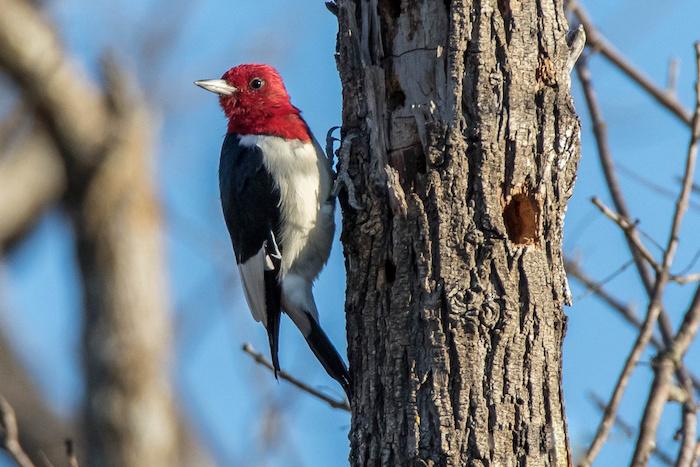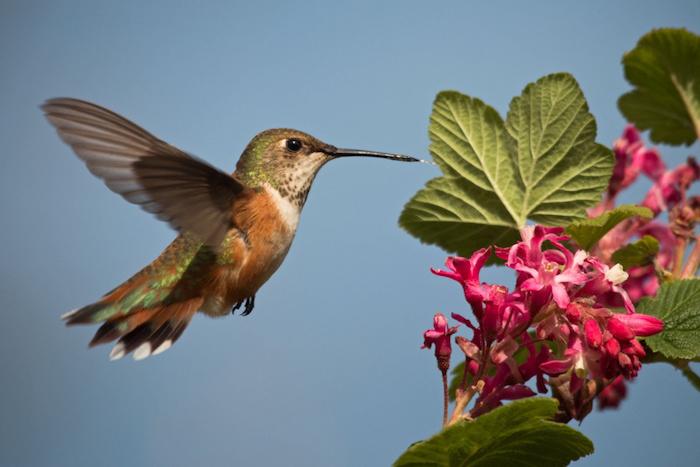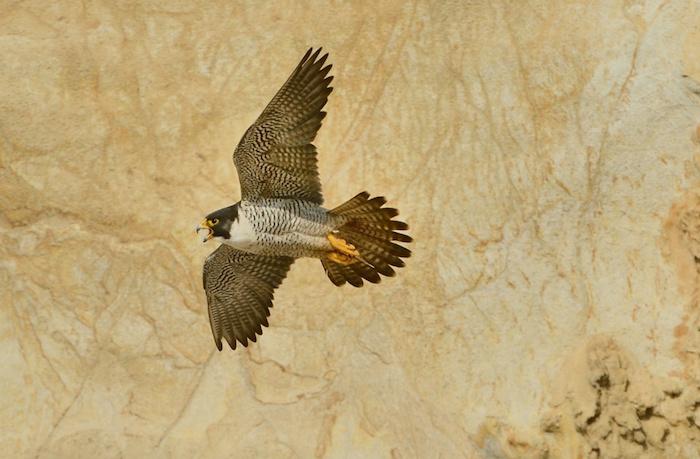"Did you see that bird???"
It's a question frequently overheard in the National Park System. And it might be uttered more often this year, the Year of the Bird. So what birds might you see in the parks, and where should you go to see them? Here are some suggestions.
One of the most recognizable birds in the U.S., the northern cardinal male is easily identified by its bright red feathers, according to Interior Department birders. More discreet, females are pale brown with red tinges in the wings, tail and crest. Common in brushy habitats, they can often be seen feeding while hopping around on the ground looking for larvae, seeds and berries.
You can spot them in Shenandoah National Park in Virginia and along the Blue Ridge Parkway in Virginia and North Carolina, at Allegheny Portage Railroad National Historic Site in Pennsylvania, Apostle Islands National Lakeshore in Wisconsin, and Boston Harbor Islands National Recreation Area, among many other park units.

A northern cardinal at Shenandoah National Park in Virginia/NPS
A favorite of birdwatchers, the spritely yellow warbler might be small in size, but it makes up for it with its bright yellow feathers. One of more than 50 species of warblers found in North America, this delightful bird is often found flitting through river thickets, like those in Mississippi National River and Recreation Area in Minnesota. These small birds with the melodious song can also be found in Chesapeake and Ohio Canal National Historical Park in West Virginia and Maryland, at Gudalupe Mountains National Park in Texas, and a version, the California yellow warbler, has been documented at Lassen Volcanic National Park in California.

A yellow warbler perched on a branch at Yukon Delta National Wildlife Refuge in Alaska/Kristine Sowl, U.S. Fish and Wildlife Service.
Mountain bluebirds are one of the most recognized birds due to their distinct, vibrant blue feathers. This fascinating blue hue is due to the microscopic structure of the feathers reflecting sunlight in the same way that molecules of air make the sky look blue. Some folks believe it's a sign of good luck if a bluebird flies in front of you. Mountain bluebirds are found across the western U.S., arriving in the northern Rockies as a sign that spring has arrived and spending the winter months in the Southwest and Mexico. You can spot them at places like Craters of the Moon National Monument and Preserve in Idaho in the summer, Arches National Park in Utah, Badlands National Park in South Dakota, Rocky Mountain National Park in Colorado, Bighorn Canyon National Recreation Area in Wyoming and Montana, and even Cape Cod National Seashore in Massachusetts.

A mountain bluebird at Seedskadee National Wildlife Refuge in Wyoming/Tom Koerner, U.S. Fish and Wildlife Service.
If you want to catch a glimpse of the green jay in the U.S., you’ll have to go to south Texas. This medium-sized bird grows to about a foot long and has a bright blue head above it’s lustrous green body. By far the most colorful of the North American jays, the green jay is often on a birder’s bucket list. As brightly colored as it is, this bird can be surprisingly hard to see in subtropical woodlands, its two-toned greens and yellows blending into the leafy tree canopies it inhabits. If you're lucky, you can spot this handsome bird at Palo Alto Battlefield National Historical Park and San Antonio Missions National Historical Park, both in Texas.

A green jay at Laguna Atascosa National Wildlife Refuge in Texas/Mike Carlo, U.S. Fish and Wildlife Service.
A checkerboard of red, white and black, red-headed woodpeckers are gorgeous and interesting birds. Red-headed woodpeckers use their powerful beaks to dig into trees, searching for insects and creating holes for food storage and nesting. Bird watchers often find them by listening for their “drumming,” an activity where woodpeckers peck loud patterns out on resonating items to communicate with other birds. Feeding on fruit and seeds, they are one of only four North American woodpeckers known to store food. Red-headed woodpeckers will fiercely defend their territory, often destroying the nests of other birds. You can find these wonderful birds in most states east of the Rockies at public lands such as Congaree National Park in South Carolina and Assateague Island National Seashore in Maryland and Virginia. But you might also see them at Big Cypress National Preserve in Florida, Buffalo National River in Arkansas, and Chickamauga & Chattanooga National Military Park in Tennessee and Georgia.

A red-headed woodpecker at Hagerman National Wildlife Refuge in Texas/MarvinAnn Patterson, U.S. Fish and Wildlife Service.
Seeing a hummingbird is always exciting. Small but mighty, the Rufous hummingbird often attacks larger birds to feed on nectar-rich flowers. It can drink up to two times its body weight per day and is a vital pollinator. The Rufous hummingbird beats its wings over 50 times per second and, like other hummingbirds, has the ability to fly backwards. Adding vivid color to forests and fields, Rufuos hummingbird females are green with orange throats, and males show bright orange feathers all over. This tiny bird migrates from Mexico to spend the summer breeding in the Pacific Northwest. Look for one at Olympic National Park in Washington.

A Rufous hummingbird at Oregon Coast National Wildlife Refuge in Oregon/Peter Pearsall, U.S. Fish and Wildlife Service.
Let’s dive in with the puffin! This bird swims underwater using its wings for propulsion and its feet for steering. There are three types of puffins: the Atlantic puffin is found along the coast of Maine and Canada, while the horned and the tufted puffins nest along the Pacific coast of Alaska and Canada. All puffins have short white facial feathers and flashy beak plates, but the tufted puffin can be distinguished by yellow feathers atop its head. Spending most of its time at sea, the puffin comes on shore to breed and nest in cliff holes and burrows. Flying is more difficult; the puffin has to beat its wings 400 times a minute to stay aloft, making any small increment of weight significant. They occasionally can be seen off the coast at Acadia National Park in Maine.

Atlantic puffins at Maine Coastal Islands National Wildlife Refuge in Maine/U.S. Fish and Wildlife Service.
The red-footed booby, the smallest of all boobies, displays a wide variety of color combinations not found in most seabirds. Getting its name from its red feet and legs, the red-footed booby also has a pale blue bill. This wonderful seabird can live up to 22 years and often begins breeding after the age of four. A monogamous bird, the female and male share egg warming duties, keeping their single egg protected with their webbed feet. A graceful hunter, it plunges into the water at high speeds to catch fish. Rarely seen in the continental U.S., the red-footed booby can be spotted at Midway Atoll National Wildlife Refuge and National Park of American Samoa.
Living year-round in most of the contiguous United States, the great blue heron is easy to spot and recognize. A wonderful combination of beauty, grace and dominance, the elegant great blue heron typically occupies wetlands, coastal or river areas such as the New River Gorge National River in West Virginia. They also are at home along the Colorado River in Canyonlands National Park in Utah and within Dinosaur National Monument in Utah and Colorado. This long-legged bird stalks the sky and shore looking for prey, its tremendous wingspan reaching up to seven feet long. The largest species of heron in North America, the great blue heron is truly a beautiful sight to behold.

A great blue heron flies over Alligator River National Wildlife Refuge in North Carolina/Eve Turek, U.S. Fish and Wildlife Service
The wild turkey is one of the largest birds in North America and can reach up to 4 feet long from tail to beak. Don’t underestimate this large, awkward bird. The turkey can fly short distances, escaping danger in tree branches and gliding back down when the coast is clear. This ground nester can also be heard calling from high points during the springtime. They are readily visible on the lawn in front of Zion Lodge in Zion National Park in Utah, occasionally can be seen strutting through Shenandoah National Park, Antietam National Battlefield, Bandelier National Monument in Texas, Carlsbad Caverns National Park in New Mexico, and many other units of the park system.

A wild turkey/Tes Jolly, U.S. Department of Agriculture.
The peregrine falcon is one of nature's swiftest and most beautiful birds of prey. Its name comes from the Latin word peregrinus, meaning "foreigner" or "traveler." This impressive bird is famous for its speed and aerial skills. Feeding primarily on songbirds, ducks and pigeons, the peregrine falcon flies high above its prey, diving in for a quick and graceful kill. Scientists have estimated the speed of a diving peregrine to be close to 200 miles per hour! Removed from the endangered species list in 1999, this bird is an excellent example of a successful recovery of a threatened species. Favoring cliffs and elevated views, the peregrine falcon can be seen at Grand Canyon National Park in Arizona, at Acadia National Park in Maine, at spots along the Appalachian National Scenic Trail, at Bryce Canyon National Park in Utah, and sometimes at Cape Lookout National Seashore.

A peregrine falcon flying above Point Reyes National Seashore in California/Leslie Scope Anderson (www.sharetheexperience.org).





